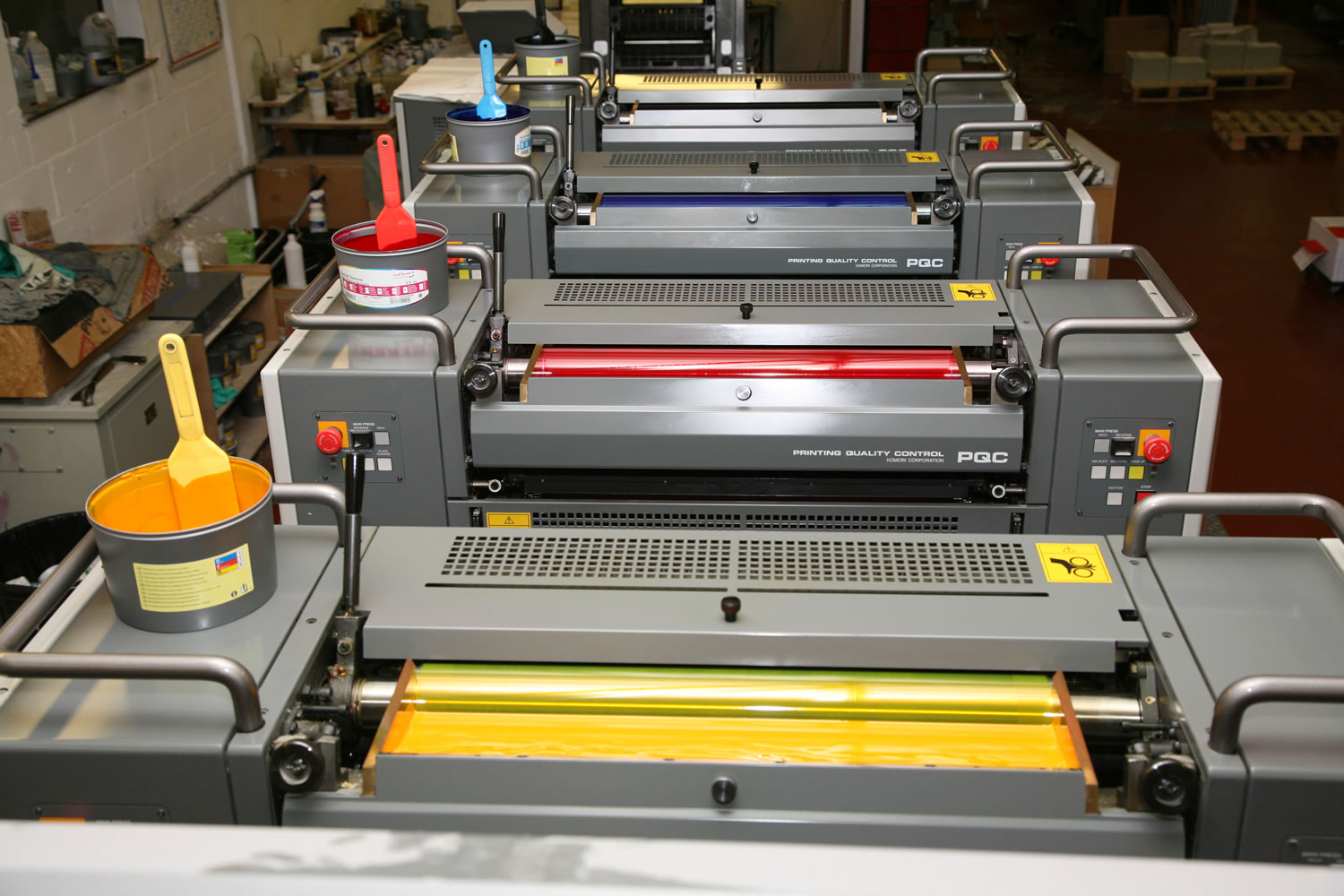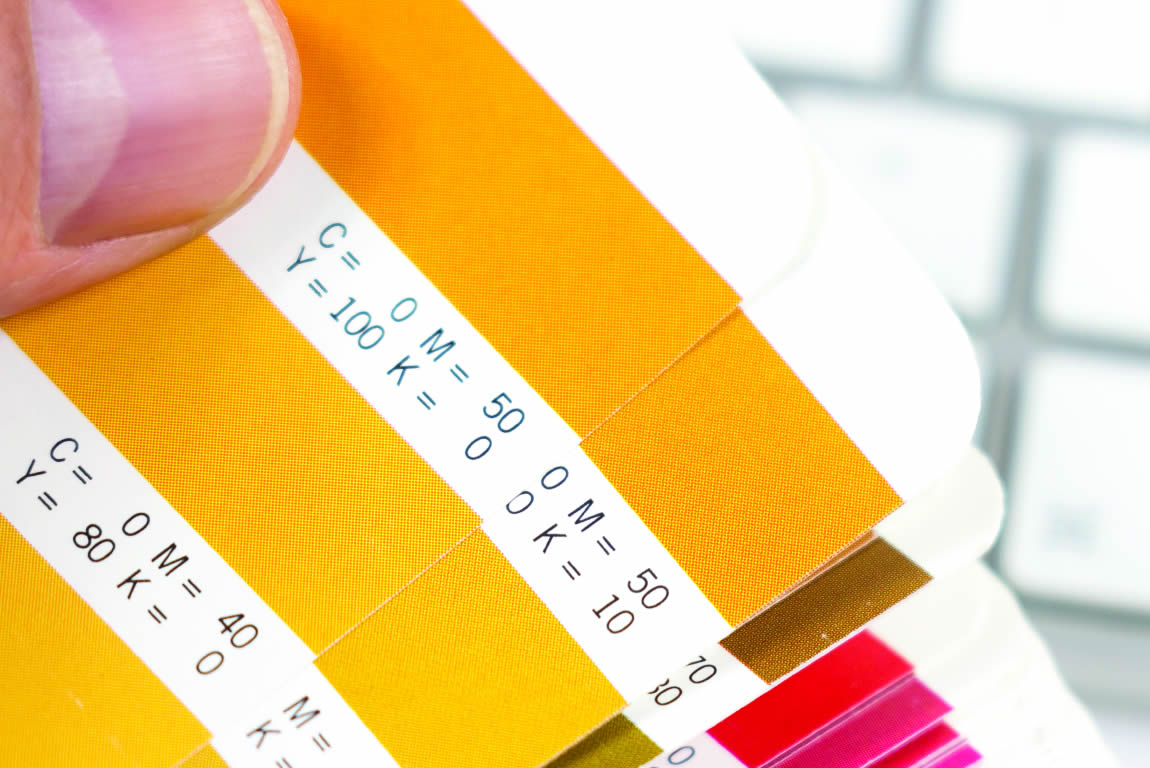Printing design and print management
The first step is to decide what printed matter is required and if possible order your print in large volumes. This reduces the unit cost. For example if you order 100 business cards @ £50.00 the unit cost is 50p, whereas 1000 business cards may only cost £100.00 with a unit cost of 10p.
Types of printers.

Working litho press showing 4 colour stations
Litho printers.
Traditional plate (lithograph) printers run expensive presses, they build that cost and print job set-up into the print run. The best value for money is to have as many units as you think you may require long term. Careful planning and research are required to get this right especially with information like addresses and telephone numbers. If that information could change consider short runs using digital printing.
Digital printers.
Digital printing has improved in leaps and bounds over the past decade and in some cases only the expert eye can tell the difference in quality. Digital printing set-up and press costs are considerably lower than litho printing. The only restrictions are the paper types available. It really depends on the print run so shop around and do the maths.
On-line printers.
Today there are many online (web) print services offering fantastic value but remember for a printer to offer you a cheap job there may be a compromise on quality and quality directly reflects on your business. Your printed business cards or flyers could be the first company media a potential new customer sees before meeting you. There’s an old saying ‘buy cheap – buy twice’!
Working with printers.
Over the years we’ve commissioned thousands of print runs and have found that a good working relationship with my printer guaranteed quality and a reasonable pricing tariff, which is better than using a “stack it high, sell it cheap” type supplier.
I once used a cheap printer who let me down badly on a magazine for a local council. Although the council officers sympathised with my dilemma, I lost the contract and over £10,000 worth of future business. I also lost credibility within the tight knit council community which was irreparable. Lesson learnt?
What do I require?
There may be many types of printed matter required for your business depending on your office processes and marketing strategy; here’s a list of common print types and sizes:
- Business cards
85mm x 55mm - Letterheads
210mm x 297mm - Compliment slips
210mm x 99mm - Single sheet flyers
148.5mm x 210mm - DL flyers
99mm x 210mm - A6 postcards
148.5mm x 105mm
Having decided on your print requirement and print run amounts, it’s time to get a price, so you need to speak a bit of print talk. Printers use a language of their own, some accommodate the layman, some like to baffle you with their science, so here are some common terms.
Paper.
Almost all litho printers use A, B or C sizes, the most common being the A series
TIP. Printers use a large sheet of paper to print then trim to size. For example A5 flyers will be printed eight up (all together), to get the best value/least wastage. Avoid bespoke sizes, there may be wastage that you pay for.
A series.
You probably already know what a sheet of A4 is, 210mm short side, 297mm long side. A5 is half that paper area, ie: halve the longest figure (297mm) 148.5mm x 210mm. For A6, A7 you continue the equation. Likewise going up the scale A3 is 420mm x 297mm.
B series. The B scale is more commonly used for larger volume printing like books. Printers presses are B scale formatted so talk to the printer to maximise the best value print size.
C series. The C scale is the common format for envelopes, ie: a C4 envelope will hold an A4 letterhead.
DL envelopes. One of the most popular business envelopes is the DL (110mm x 220mm) which holds an A4 sheet folded twice (to make a 210mm x 99mm area).
TIP. You can purchase DL envelopes very cheaply with pre-gummed seals and windows for the letterhead address area saving time in the office.
Paper weight.
Usually shown as ‘gsm’ (grammes per square metre), weight is based on 1 single standard sheet of paper 1 metre x 1 metre in size. This however is totally irrelevant when instructing a printer because most keep a stock of the popular weights. Therefore if you order business cards they should by default be printed on their in-stock 350gsm paper. Letterheads are usually printed on 100gsm paper, and it’s the same for compliment slips.
TIP. Do not ask for a ‘non-stock’ paper weights, the printer will have to order this in as a special and charge you even if you do not use all of it on your print job.
Paper appearance.
There are options on the paper surface or ‘finish’ so consider the following.
Uncoated paper
For printed matter to be written on or used with an office printer like your ink jet or laser printer (there are a large range of laser/ink jet printer compatible papers)
Silk paper
For a better looking quality but not too reflective. Silk papers also print slightly better so fine text and images will appear sharper.
Gloss paper
Is the best quality and can bring out the most in your publication but they do reflect light and cannot be written on very easily.
Additional finishes.
Litho printers can add a varnish to the printed document, this is used mainly when printing in colour. Varnishes come in a range of reflectiveness, protect the inks and reduce edge and fold cracking. They are well worth considering for a brochure cover for example.
TIP. Be guided by your printer on paper weight, finish and sizes. If you go non-standard it will cost you more.
Also see: print finishing
Colour printing.
Both litho and digital printers use just 4 colours to print on their presses. This is known as CMYK or 4 colour process printing.
C = Cyan
M = Magenta
Y = Yellow
K = Black or ‘key’
Litho presses can also run additional ‘special’ colours which may be important if a specific colour for say a logo is required.

Pantone PMS colour swatch
Colour charts.
The print trades use industry standard colour charts that predefine colours. Using the CMYK values it is possible to select print-safe colours that will reproduce without drastic changes.
The most popular of these is the Pantone Matching System (PMS) which allows you, the buyer, to define a set colour.
For example you may decide that PMS1797 is to be used as your corporate red. The printer will know that PMS1797 is made up of 0% cyan, 100% magenta, 99% yellow and 4% black (K) inks. More importantly your designer will have these values already available in their design program. The designer will also be able to convert that value back to RGB (red, green, blue) for web/screen use, ie: a web design.
TIP. If you use CMYK values for your logo, write them down and keep them safe for future reference.
Proofing.
Printing in 4 colours (CMYK) can change colour values from the screen image you have already seen at the design stage so it’s always wise to ask for a paper proof. This will highlight any changes before you commit to the final print run. This process is especially important when you are using your logo, images, corporate colours for the first time.
Mail lists.
Your business may require posting information to large groups of customers, typically a brochure. There are specialist companies that can take your mail list and pack/post for you. Some printers do this ‘in-house’ as well so if this is a requirement it may be cheaper to source that printer and get an all in one package.
TIP. Visit the printer and ask to see the mailing section, some printers will say they do it in-house but actually sub-contract the work. Mail lists contain sensitive data so the mailing company should be registered with The Information Commissioner’s Office (ICO).
Getting the best out of your printer.
The on-line (web) print suppliers are not going to be as flexible with pricing as your local supplier unless it’s a good size order. I recommend that you use a well established local company.
Why local?
A local company will almost certainly offer discounts for regular orders. They survive on word of mouth referrals so the print is going to be of a good standard plus their in-house designer will hold your work on file (digital) making re-orders quick and painless.
With high volume printing you can also ask to see the print run in progress to check the print quality as it comes off the press. I’ve taken clients to my local printer and stood them at the end of the press. It’s a great experience watching your creativity flying across the rollers. You have the added bonus of checking the colours and if required correcting colour balance as the press is running. If you’re really lucky you might get a cup of tea!
TIP. Make sure you check your proofs before you approve a design and go to print. You can blame the printer but it’s not their fault if the content is wrong. Check and check again – you will have to pay for the printing even if there’s a typo on it.
TIP. If you compiled the data for a print design, get someone else to look over the proof for spelling mistakes. Don’t rely on your spell checker. Read backwards to find silly errors as your mind’s eye skips words when reading left to right.

